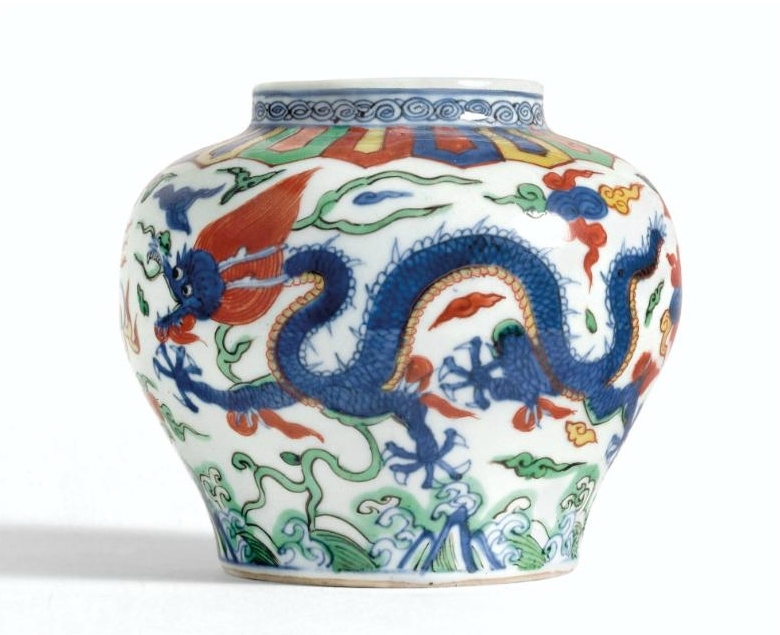A finely enamelled Wucai 'Dragon' Jar, Mark and period of Wanli (1573-1620)
Lot 32. A finely enamelled wucai 'Dragon' Jar, Mark and period of Wanli (1573-1620); 11.2 cm., 4 3/8 in. Estimate 2,500,000-4,000,000 HKD. Lot sold 3,140,000 HKD. Photo Sotheby's
well proportioned with a short straight neck and a low footring, vividly painted in intense tones of the wucai palette with two five-clawed dragons, one red and one blue, each chasing a 'flaming pearl' among stylised clouds and above waves crashing over rocks, all below blue scrolls collaring the neck and colourful pendent lappets draping over the shoulder, composed of a vivid underglaze blue, two shades of iron red, bright green and yellow enamels, the base inscribed with an underglaze blue six-character reign mark within a double ring
PROVENANCE: Eskenazi Ltd, London.
EXHIBITED: Chinese Ceramics from the Meiyintang Collection, The British Museum, London, 1994.
Evolution to Perfection. Chinese Ceramics from the Meiyintang Collection/Evolution vers la perfection. Céramiques de Chine de la Collection Meiyintang, Sporting d'Hiver, Monte Carlo, 1996, cat. no. 138.
LITTERATURE: Regina Krahl, Chinese Ceramics from the Meiyintang Collection, London, 1994-2010, vol. 2, no. 723.
NOTE: This jar appears to be unique, but it represents the quality of imperial Wanli porcelain at its best and embodies the distinctive style of the porcelain production during that reign. It is very rare to find a piece of wucai porcelain on which the design is so clearly laid out, all the colours have fired to such brilliant tones, and the range of colours has been employed to such dramatic effect. It is also most unusual for the basic Wanli wucai palette to have been extended by the clearly intentional creation of a thinner iron-red wash to create a pale pink tone, as seen here on the stylized lotus petals around the shoulder.
The superior quality of this piece becomes obvious when comparing it to other fine Wanli wucai pieces, such as for example three pieces in the Shanghai Museum, illustrated in Lu Minghua, Shanghai Bowuguan zangpin yanjiu daxi / Studies of the Shanghai Museum Collections : A Series of Monographs. Mingdai guanyao ciqi [Ming imperial porcelain], Shanghai, 2007, pls 3-102 to 3-104.
In its strong impact, this jar is most closely related to the rare and brilliantly coloured doucai jars of the Chenghua period (AD 1465-87), which may have been in the minds of the potters creating it, although they did not directly copy any Chenghua prototype. The Wanli Emperor is known to have felt a particular affinity to his great-great-grandfather Chenghua, whom he admired as a person, and to have been very fond of Chenghua porcelain. Compare, for example, the famous jar in the British Museum, London, illustrated in Jessica Harrison-Hall, Ming Ceramics in the British Museum, London, 2001, no. 6: 14 (fig. 1).
While the present jar represents a very free interpretation of the Chenghua design, closer copies, stylistically more in tune with the Chenghua style, were also produced in the Wanli reign, but without reign mark; compare an unmarked wucai jar of the Wanli period decorated with blue dragons, sold at Christie's New York, 30th March 2005, lot 341, from the Samuel C. Davis Collection in the St. Louis Art Museum.
Sotheby's. The Meiyintang Collection, Part III - An Important Selection of Imperial Chinese Porcelains. Hong Kong | 04 Apr 2012, 10:15 AM

/https%3A%2F%2Fprofilepics.canalblog.com%2Fprofilepics%2F1%2F0%2F100183.jpg)
/https%3A%2F%2Fstorage.canalblog.com%2F03%2F02%2F119589%2F96711876_o.jpg)
/https%3A%2F%2Fstorage.canalblog.com%2F11%2F31%2F119589%2F94773502_o.jpg)
/https%3A%2F%2Fstorage.canalblog.com%2F20%2F83%2F119589%2F94772815_o.jpg)
/https%3A%2F%2Fstorage.canalblog.com%2F26%2F72%2F119589%2F75604929_o.jpg)
/https%3A%2F%2Fstorage.canalblog.com%2F59%2F60%2F119589%2F26458628_o.jpg)





/image%2F1371349%2F20240325%2Fob_f3f664_telechargement-7.jpg)
/image%2F1371349%2F20240325%2Fob_bb86e3_telechargement.jpg)
/http%3A%2F%2Fstorage.canalblog.com%2F43%2F39%2F119589%2F129858579_o.jpg)
/http%3A%2F%2Fstorage.canalblog.com%2F66%2F03%2F119589%2F129677087_o.jpg)